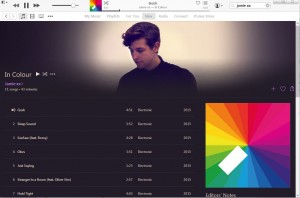I find myself missing that Beats Music more than I’d expected. I liked the look and feel of it. Most everything I searched for was there (with the exception of streaming holdouts like The Beatles). I had a sentimental attachment to Beats after all the work I’d personally done for them.
Because I relied so heavily on Beats Music, I find myself somewhat out of the loop when it comes to other services. As a way to find my new favorite, and educate myself about what’s out there, for the past few months I’ve been checking out other “on-demand” music services.
First up:
Apple Music.
Initial Impressions: Ugh. I don’t understand why I have to download iTunes. A streaming service should require an app download on a mobile device, but it shouldn’t require a desktop download. It’s an outdated approach, and a barrier to entry. Why should I have to download a desktop client in order to get quick access to on-demand music?
From there, I found the Apple Music portion surprisingly difficult to find. It seems like an odd branding decision to keep iTunes and Apple Music somewhat separate, but one has to be accessed through the other. To find Apple Music, I had to click the “For You” tab on iTunes.
Beyond the initial hurdles, setup was relatively straightforward. Weirdly enough, it probably helps in my case that I haven’t been using a lot of Apple products lately. I have an old iPod, but I’ve never had an iPhone or iPad. My desktop computer doesn’t have a lot of music on it. Most of the issues I’ve heard about setting up a new Apple Music account have to do with the match feature, which didn’t apply to me. I wasn’t able to move my (small) music library from Beats to Apple, but that probably had more to do with me using a different last name and email address than anything else.
Search function: One of the things I miss about Beats is that an artist’s page would list albums that were deemed “essentials”, as well as “latest releases”. I think Apple’s search results are a little jumbled, and their search might not be as powerful. For example, while searching for Anthony de Mare’s Liaisons — Re-imagining Sondheim From The Piano, I see the artist Anthony de Mare show up, but I don’t see the album, and I can’t seem to find it while clicking through Anthony de Mare’s page. What makes it weirder is that the album art has been selected for the artist’s art, so it’s probably intended to be available for streaming, but I can’t find it.
Recommendations: Perhaps what interests me most about each service is their ability to recommend music to me. Apple has learned a little more about my tastes since I set it up, but it’s still a little off. My first recommendations were an intro to Spoon playlist (no) and an Alt-Country playlist (after I’d let them know I hate country). Radiohead, Kanye West, and Wilco are a little more attuned to my preferences, but that’s because I selected them from the bubbles when I signed up.
Aesthetics: Apple is nothing if not sleek. The artist’s image is nicely integrated, and all the info I’d want at a glance is there. However, the UX isn’t perfect: I don’t love the way the search results look, especially since it seems to take a while to load. I’m also annoyed by the way the current song is displayed: it shows or scrolls across the top of the window, separated from all the other pertinent info, in a too-small font.
Playlists: I think Apple brought a lot of the Beats playlists over with them, including the wide array of curators (Downbeat, Pitchfork, etc.; they seem to have lost Naxos, whose witty playlists I miss). I like the “Intro” playlists, and there seems to be a fair amount of activity-based playlists. I spend more time listening to curated playlists than anything else, so the only improvement would be an even greater number of them, and I wish the playlists recommended to me were changed up on a more frequent basis. The other downside is the roundabout access to Playlists. I’m not sure whether this is the best way, but I’ve been accessing them via the “All Genres” pull-down menu on the “New” tab.
Mobile app: I tend to do most of my listening via desktop, so while I’ve heard negative experiences of the Android app, I haven’t encountered many issues during my limited usage of it. However: it’s frustrating that there isn’t an Apple Music app for my Android tablet (running Marshmallow), but there is one for my phone (same OS). Maybe that’s Google’s fault, not Apple’s. The other main issue I have is that it doesn’t have Chromecast support, so I can’t cast it to my TV at home. When it comes to playing music at home, we usually opt for Spotify for that reason.
Summary: Apple’s vast music library and lovingly-curated playlists shine. The UX is decent, but reliance on iTunes is a deal-breaker for me. The lack of an Android tablet app and Chromecast make it even more of a chore to use. I’m looking forward to checking out other services, and will only return to Apple if I find other services’ playlists lacking.

